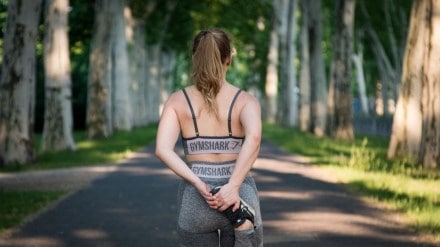World Physiotherapy Day 2025: An important day that recognises the work of physiotherapists around the world, World Physiotherapy Day is also an opportunity to acknowledge the power of simple exercises for healthy ageing. While men and women both face health challenges as they grow old, both genders face unique challenges. In case of women, their journey after the age of 40 takes a different turn as the phase of peri-menopause marked by hormonal fluctuations could lead to faster bone density loss, leading to higher risk of osteoporosis. The changes in metabolism can also increase risk of belly fat.
The good thing is that these changes can be addressed with a set of healthy lifestyle interventions. Certain exercises can strengthen bones and muscles, support joint health, and prevent cardiovascular issues in women.
Neha Gill, Senior Physiotherapist at Cloudnine Group of Hospitals, Chandigarh, in an interview with Financial Express.com, shares a set of simple exercises women can include in their routine for healthy and graceful ageing.
Why exercises matter for women as they age
“During each stage of life, a women body undergo tremendous changes especially during pregnancy. Years later her body undergoes a lot of hormonal fluctuations due to menopause, which leads to faster bone density loss, leading to a higher risk of osteoporosis, and greater hormonal fluctuations that can impact muscle strength, flexibility, and metabolism. Sedentary lifestyles, often linked with modern work patterns, add to these challenges,” says
Regular exercise, however, has been shown to improve bone and joint health, prevent stiffness and chronic pain, helps in maintaining good posture, enhance balance and coordination, reduce fall risk, support mental well-being and reduce stress.
Key exercises for women to age gracefully
1. Strength training
Muscle mass naturally declines with age, but resistance training helps counteract this process. It also helps in reducing the risk of heart diseases and diabetes. A simple body-weight or resistance band exercises can work wonders:
Squats: Strengthen thighs, hips, and glutes, making everyday activities like sitting and climbing stairs easier.
Wall push-ups: Build upper-body strength without straining the joints.
Resistance band rows: Improve posture and back strength, which are vital as women age.
Strength training at least 2–3 times a week helps women retain muscle mass, improve metabolism, and support joint health.
2. Weight-bearing activities for bone health
Bone density peaks in early adulthood and declines after 30, especially post-menopause. Weight-bearing exercises stimulate bone growth and slow down bone loss. Here are some of the exercises to try:
Brisk walking or jogging: Enhances cardiovascular health and strengthens bones.
Dancing or Zumba: Fun, rhythmic activities that combine fitness with joy.
Step-ups: Using stairs or a raised platform to strengthen legs and improve balance.
These activities are especially recommended for women at risk of osteoporosis.
3. Core stability and balance training
Good core strength protects the spine, reduces the risk of falls, and improves functional movement. Post birth, it is important to get yourself assessed for diastasis recti. For this, there are specific exercises which help in the healing of diastasis recti.
Here are some of the core strengthening exercises and Yoga poses that are recommended for women:
Planks: Effective for building core endurance.
Bridge pose: Strengthens lower back and pelvic muscles.
Single-leg stands: Enhances balance and stability and is crucial in preventing falls as women age.
Regular balance training can significantly reduce fracture risks in older women.
4. Flexibility and mobility work
As women age and sedentary lifestyle, joints may stiffen and muscles lose elasticity. Mobility exercises maintain range of motion and reduce pain. Flexibility exercises help in maintaining muscle length.
Yoga: Improves flexibility, balance, and mental well-being.
Stretching routines: Focused stretches for hamstrings, shoulders, and hip flexors can keep stiffness at bay.
Tai Chi: A gentle, flowing exercise that enhances both flexibility and mental calmness.
These practices also support stress management and emotional health during menopause and beyond.
5. Pelvic floor exercises
Many women silently struggle with urinary incontinence or pelvic organ prolapse as they age, often due to childbirth or hormonal changes. Strengthening pelvic floor muscles is key. Here are a few exercises:
Kegel exercises: This involves contracting and relaxing pelvic muscles to improve bladder control.
Bridge with pelvic tilt: Engages both the pelvic floor and core muscles.
Physiotherapists can guide women on proper pelvic floor training techniques to improve quality of life and prevent discomfort. But before starting kegel exercises, it is important to have an assessment first.
6. Low-impact cardiovascular exercises
Cardio supports heart health, stamina, and weight management. For women with joint issues, low-impact options are highly effective:
Swimming: A full-body workout that is gentle on the joints.
Cycling (stationary or outdoor): Improves cardiovascular endurance without stressing knees and hips.
Elliptical training: Provides aerobic benefits with minimal impact.
Tips for women to stay consistent with their exercise routine
Start small, progress gradually: Begin with 10–15 minutes daily and increase the intensity over time.
Mix it up: Combine strength, cardio, flexibility, and balance exercises for overall fitness.
Listen to your body: Pain is a signal. Physiotherapy helps identify safe modifications.
Exercise together: Group classes, walking clubs, or yoga sessions build motivation and enjoyment.
Prioritize rest and recovery: Adequate sleep and relaxation are as important as workouts.
